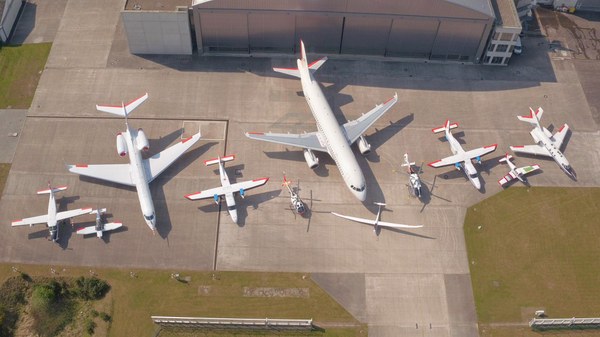DLR’s Flight Operations Facility is responsible for the deployment and utilisation of DLR’s fleet of highly-modified research aircraft.
Discus-2c DLR: D-9833


The Discus 2c-DLR represents a new generation of aircraft for aeronautical research on small aircraft in almost every way. Its structural design makes this progress apparent. The Discus is largely made of the carbon-fibre reinforced polymers (CFRP) commonly used today. It is based on a standard high-performance glider with an 18-metre wingspan. The research that can be conducted with this glider goes far beyond pure aerodynamics to cover issues relating to flight mechanics, aeroelasticity, measurement technologies, human-machine interaction and certification, among others. For research into digitalisation, the DLR Discus-2c serves as a prototype for the development of and research into a digital twin.
The Discus 2c-DLR represents a new generation of aircraft for aeronautical research on small aircraft in almost every way. Its structural design makes this progress apparent. The Discus is largely made of the carbon-fibre reinforced polymers (CFRP) commonly used today. It is based on a standard high-performance glider with an 18-metre wingspan. The research that can be conducted with this glider goes far beyond pure aerodynamics to cover issues relating to flight mechanics, aeroelasticity, measurement technologies, human-machine interaction and certification, among others. For research into digitalisation, the DLR Discus-2c serves as a prototype for the development of and research into a digital twin.
The aircraft fuselage has a special storage compartment that offers a lot of space for extensive measurement technologies. All of the cable ducts that are already integrated into the structure lead to this storage space. Standardised attachment points allow the installation of special boxes containing measurement electronics, which can be changed easily thanks to the standardised format and precisely specified interfaces. The modularity created in this way makes the Discus extremely flexible in serving campaigns with different requirements.
In conjunction with the Technical University of Braunschweig, the Discus' measurement sensor systems were planned at the time of the aircraft's procurement and integrated into the still-open structural shells during the construction phase. For example, 48 strain gauges were installed in the fuselage and wings in order to be able to measure the loads under different flight conditions. In addition, 22 measurement points with fibre Bragg gratings have been installed in the aircraft, allowing the deflections of the structure to be measured with a high degree of precision. The Discus also has magnetic field probes and acceleration sensors at various points on the structure, sensors on all of the control surfaces, an inertial measurement unit in the fuselage, a nose boom with a five-hole probe to detect flow angles and speeds, and a data acquisition system for recording the measurement data. The experimental autopilot offers the option of effecting predefined control surface inputs with a high level of precision and repeatability. This provides optimum support for flight mechanics studies, for example.
As the successor to the DG-300/17, the DLR Discus-2c serves as a reference aircraft for gauging the performance of new glider types. The flight performance of the Discus was precisely measured in the form of its polar curves. These curves are now much flatter, particularly at higher speeds, due to advances in aerodynamics. As a modern design with high aerodynamic potential, the Discus is ideally suited to comparisons with modern high-performance gliders. Since the replacement of the DG-300/17, the Discus has been used to determine the polar curves of approximately 20 gliders, including prototypes, one-off designs and modified variants.
Technical data
Discus-2c DLR | Data |
|---|---|
Length: | 6.8 metres (plus nose boom) |
Height: | 1.3 metres |
Wingspan: | 18 metres |
Total mass: | 565 kilograms |
Water ballast: | 208 litres |
Wing loading: | maximum 52 kilograms per square metre |
Best glide ratio: | 45,9 |
Landing gear: | retractable sprung system |
Maximum speed: | 280 kilometres per hour |
Minimum speed: | 75 kilometres per hour |
DLR Flight Operations: | Braunschweig |

